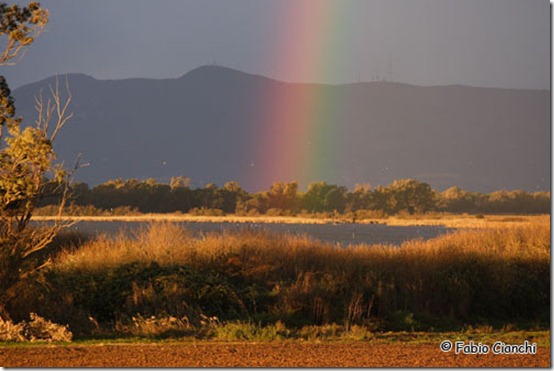Allarme per l’Ombrone Posted by Geoff on Aug 30, 2012 in News
A few days ago, in a blog called Il Temporale (The Storm), I wrote about the incredible dry heat we’ve experienced here this summer. I talked about the impact that this siccità (dryness) has had on the environment, and how it had desiccated our orto (vegetable garden). Here’s an article that I found, with some alarming news about the damage that is being done by this extreme climate to the natural habitat of la foce del fiume Ombrone (The mouth of the river Ombrone)and it’s surroundings.
Allarme per l’Ombrone
Maremma: per la siccità i fiumi diventano salati
L’acqua salata del mare risale il corso dei fiumi in secca. A rischio numerose specie del Parco dell’Uccellina
Allarm for the river Ombrone
Maremma: the rivers are becoming saline due to the dryness
The salty sea water is flowing up the drying rivers. Many species in the Parco dell’Uccellina are at risk
La foce del fiume Ombrone
GROSSETO – La sorpresa più grande sono state le meduse. Le hanno trovate a diversi chilometri a ovest dalla foce dell’Ombrone, il fiume principe della Maremma. E con loro c’erano triglie, orate e altri pesci di mare. Un segnale oscuro per l’ambiente di questo tratto in parte ancora incontaminato della provincia di Grosseto che custodisce quel gioiello naturale che è il Parco dell’Uccellina, perché significa che l’acqua del grande fiume sta diventando salina a causa della siccità e del cambiamento climatico.
The mouth of the river Ombrone
GROSSETO – The biggest surprise are the jellyfish. They have been found several kilometres west of the mouth of the Ombrone, the main river of the Maremma (see link: Parco Naturale Della Maremma) And along with the jellyfish there were also mullet, sea bream and other salt water fishes. A dark sign for the environment of this still uncontaminated stretch of Grosseto province, that is home to that natural jewel known as il Parco dell’Uccellina, because it means that the waters of the great river are becoming saline due to the dryness and the change in climate.
ALLARME – A lanciare l’allarme ambientalisti e guardiani del parco, che proprio in questi giorni hanno eseguito numerosi accertamenti. Neppure Beatrice qui è riuscita a portare un po’ di sollievo. “La situazione è molto grave”, conferma Fabio Cianchi, coordinatore delle oasi del Wwf della provincia. “In 22 anni di lavoro da sentinella ambientale mai avevo visto una situazione così grave”.
ALLARME – The alarm was raised by environmentalists and park wardens, who over the last few days have carried out numerous checks. Not even Beatrice (the big rain storm that arrived at the weekend) has managed to bring any relief to the area. “The situation is very serious” confirms Fabio Cianchi, coordinator of the oasis of the province. “In 22 years of work as an environmental observer I’ve never seen such a serious situation”.
ANIMALI A RISCHIO – E non c’è solo il sale marino dell’Ombrone a preoccupare ambientalisti e ricercatori universitari, ma anche la condizione di uccelli migratori rarissimi, dei mammiferi e di altri animali. La testuggine d’acqua, specie minacciata d’estinzione, è quasi scomparsa, folaghe, martin pescatore, germani reali soffrono terribilmente. Così come gli abitanti dei boschi, soprattutto quelli che vivono protetti nel parco, come la volpe.
ANIMALS AT RISK – And it’s not just the marine salt in the Ombrone that’s worrying environmentalist and university researchers, but also the condition of rare migratory birds, of mammals and other animals. The water tortoise, a species threatened by extinction, has almost disappeared, coots, kingfishers, and mallards are suffering very badly. It’s the same story for the inhabitants of the woods, especially those that live under protection in the park, such as the fox.
Above: A view of lake Burano
SICCITÀ – La siccità ha poi ridotto paurosamente il livello del lago di Burano, rifugio essenziale per i migratori e le paludi, come la Diaccia Botrona, habitat indispensabile per la sopravvivenza di numerose specie. “Nel lago di Burano il nostro pluviometro ha registrato 165 millimetri di pioggia”, spiega Cianchi, “quando nel torrido anno 2003 si era fermato a 400 e già allora le cose andarono male”. Adesso la speranza è che il tempo cambi e torni a piovere. La Maremma e i suoi tesori naturalistici possono resistere in questi condizioni non più di un paio di mesi.
DRYNESS – The dryness has also dangerously reduced the level of lake Burano, an essential refuge for migratory bird, and marshlands, such as the Diaccia Botrona, an indispensible habitat for the survival of numerous species. “In lake Burano our rain gauge has registered 165 millimetres of rain” explains Cianchi, “whilst during the very hot year of 2003 it reached 400 millimetres, and even at that time things were looking bad”. Now the hope is that the weather will change and it will begin to rain. The Maremma and its natural treasures can only continue to resist in these conditions for no more than a couple of months.
Original article by: Marco Gasperetti, 28 agosto 2012

Build vocabulary, practice pronunciation, and more with Transparent Language Online. Available anytime, anywhere, on any device.





Comments:
joseph:
climate change in any language is a serious problem